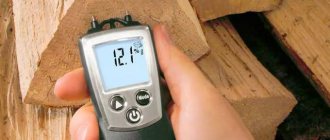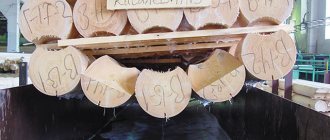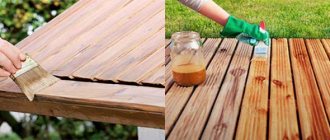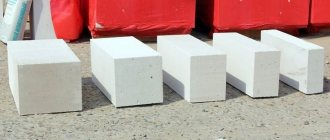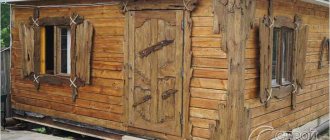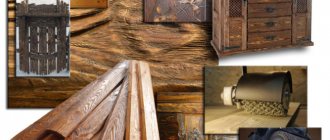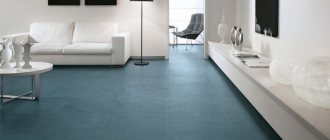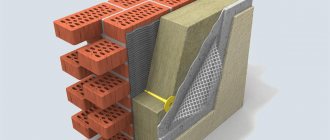As the tree grows, it fills with water from the ground through its roots. This way it absorbs nutrients that promote development. Then, when the trunk is cut down into blanks, some of the moisture remains with it. Wood moisture content should not exceed 22%. Below 15% it will not be possible to dry it naturally, since the external environment also feeds the material with liquid. The indicator of the amount of moisture affects the properties of wood and how it will behave during processing. Excessive amounts of water lead to mold and rot.
Natural humidity
The indicator is used to determine the amount of water inside the trunk immediately after cutting or during growth. It determines the quality of drying of wood materials. The natural moisture content of wood is considered the initial value, on the basis of which calculations for drying the material begin. If the indicator is determined incorrectly, there is a risk of under- or over-drying the lumber.
What percentage of water is contained in the trunk is determined by the following factors:
- wood structure;
- porosity;
- environment.
The natural moisture content of wood ranges from 30 to 80% and varies depending on the type of material. They are used as a starting point before determining the optimal drying mode to achieve the desired quality of the dry workpiece.
| Breed | Humidity, % | ||
| Cores | Sapwood | Average | |
| Birch | — | 70-90 | 78 |
| Oak | 50-80 | 70-80 | 70 |
| Spruce | 30-40 | 100-120 | 91 |
| Larch | 30-40 | 100-120 | 82 |
| Aspen | — | 80-100 | 90 |
| Pine | 30-40 | 100-120 | 88 |
| Ash | 35-40 | 35-40 | 38 |
| Fir | — | — | 101 |
| Cedar | — | — | 92 |
Deciduous wood has a lower natural moisture content than coniferous wood. This is due to the structure of wood. Spruce contains up to 90% moisture, fir contains up to 92%. For comparison, ash wood contains only 36%. In addition, the percentage of water in the material is influenced by the state of the environment. In winter, plants go into “dormant mode” and practically do not consume nutrients from the ground. Therefore, humidity in summer is much higher than in winter. Also, freshly cut wood has a much higher moisture percentage than older wood.
The task of those involved in lumber processing is to reduce moisture content to the lowest possible percentage. This is done so that the workpieces acquire the necessary hardness and strength. The wear and tear of products whose material has successfully undergone the drying process is significantly lower.
Humidity also affects the size of the workpieces. The more the material dries out, the smaller in size it becomes. Proper drying should be organized in such a way that moisture evaporates evenly. Then the weight and size of the workpiece will be standard, and the material itself will acquire the necessary properties. The latest methods of drying wood reduce the percentage of humidity to 6. This indicator also depends on the species, structure of the tree, and time of year.
Heavily dried wood is not used for construction, as it can crack. The amount of water in the material for these purposes is reduced in the following ways:
- Self-drying. A ready-made cut of natural moisture is purchased and laid out in stacks on the site. Gaps are made between the rows of boards using bars so that air can circulate freely. The supports must be placed at least 1.5 meters apart from each other, and the material will not bend. To prevent rain or other precipitation from spoiling the wood, the structure is covered with film or roofing felt on top. Natural drying is best done in the warm season. Materials are placed in the shade, under a canopy. Thin-width boards will dry out faster than thick ones. The structure is installed on pads made of pine branches or protective material.
- Purchase of finished material. In this case, the seller has already prepared the boards and dried them naturally on his own.
- If it is necessary to reduce the amount of moisture to 15% or lower, then chamber drying is used indoors. Such materials will be more expensive, since processing will require a large waste of resources. And it is better not to use such wood for construction, it can crack.
The ideal use of dry wood is furniture and interior items.
Where is it used?
Timber marked EB is actively used in various fields. In terms of reliability, durability and other characteristics, such lumber is not inferior to dry lumber. At the same time, it costs less.
This type of raw material has found its application in the following areas.
- Available auxiliary material in road construction. Timber is also a wonderful addition to basic building materials in residential or industrial construction.
- The timber can be used for the construction of canopies and various seasonal structures.
- Blanks for profiled timber are made from this lumber. To achieve this, wood undergoes a series of treatments, including drying, defect detection and other processes.
Professional opinions differ regarding the advisability of using natural moisture timber . Some note positive qualities, such as affordable price and optimal performance. With the advent of this type of material, many have the opportunity to build an inexpensive house from timber on their own.
Other experts point out shortcomings. Among them are the need to use additional insulation, costs for cladding, as well as increased construction time.
You also need to take into account that this type of material shrinks. Large cracks appear and the shape of some wooden elements changes.
EB board is suitable for flooring or building a frame house. To do this, natural raw materials must have other necessary characteristics (density, wear resistance, etc.). Only in this case will the frame be sufficiently reliable and withstand the necessary load.
Equilibrium humidity
In order for lumber to be stored for a long time and not rot, it must be properly dried. To carry out the procedure, you will need an indicator of the equilibrium moisture content of the wood. It is achieved by long-term exposure of lumber to a certain external environment. When external conditions change, the equilibrium humidity also changes.
| Equilibrium moisture content of wood at different temperature and humidity conditions in winter huts | ||||||
| Month | In the external environment | In winter huts | ||||
| Air temperature, C | Air humidity, % | Equilibrium moisture content of wood, % | Air temperature, C | Air humidity, % | Equilibrium moisture content of wood, % | |
| April | 8,8 | 59 | 11,4 | 5,9 | 79 | 15,7 |
| May | 17,0 | 49 | 9,3 | 8,3 | 86 | 16,7 |
| June | 20,6 | 53 | 10,0 | 10,5 | 92 | 21,0 |
| July | 18,0 | 54 | 10,3 | 12,4 | 90 | 20,9 |
| August | 16,4 | 69 | 13,1 | 11,6 | 87 | 19,5 |
| September | 14,3 | 72 | 13,0 | 11,8 | 84 | 16,1 |
| October | 6,3 | 63 | 9,0 | 5,9 | 68 | 11,6 |
| November | -4,1 | 85 | 17,4 | -4,1 | 65 | 10,6 |
Excessive amount of moisture in the rock negatively affects the condition of the finished product and spoils the workpiece. Lumber becomes moldy when exposed to water, and fungus grows in it. Wood is porous in structure and absorbs moisture easily. It is also easy to get rid of it by decreasing or increasing in size. As a result, if the indicator is calculated incorrectly, some areas of the wooden structure may begin to bulge over time or settle. And then, under the influence of the external environment, they will be smoothed out again.
The degree of humidity in coniferous and deciduous species is different. For clear sorting of lumber, it is divided into 3 grades according to the percentage of water in the composition:
- Raw wood. Contains more than 35% moisture.
- Semi-dry. In the range from 25 to 35%.
- Dry. Less than 25%.
The following is a table of the equilibrium moisture content of wood depending on temperature and relative humidity:
| t, C | Relative humidity, % | |||||||||||||
| 35 | 40 | 45 | 50 | 55 | 60 | 65 | 70 | 75 | 80 | 85 | 90 | 95 | 98 | |
| 0 to 5 | 7,1 | 7,9 | 8,7 | 9,5 | 10,4 | 11,3 | 12,4 | 13,5 | 14,9 | 16,5 | 18,5 | 21,0 | 24,3 | 26,9 |
| 10 | 7,1 | 7,9 | 8,7 | 9,5 | 10,3 | 11,2 | 12,3 | 13,4 | 14,8 | 16,4 | 18,4 | 20,9 | 24,2 | 26,8 |
| 15 | 7,0 | 7,8 | 8,6 | 9,4 | 10,2 | 11,1 | 12,1 | 13,3 | 14,6 | 16,2 | 18,2 | 20,7 | 24,1 | 26,8 |
| 20 | 6,9 | 7,7 | 8,5 | 9,2 | 10,1 | 11,0 | 12,0 | 13,1 | 14,4 | 16 | 17,9 | 20,5 | 23,9 | 26 |
| 25 | 6,8 | 7,6 | 8,3 | 9,1 | 9,9 | 10,8 | 11,7 | 12,9 | 14,2 | 15,7 | 17,7 | 20,2 | 23,6 | 26,3 |
| 32 | 6,7 | 7,4 | 8,1 | 8,9 | 9,7 | 10,5 | 11,5 | 12,6 | 13,6 | 15,1 | 17,0 | 19,5 | 22,9 | 25,6 |
| 40 | 6,5 | 7,2 | 7,9 | 8,7 | 9,5 | 10,3 | 11,2 | 12,3 | 13,6 | 15,1 | 17,0 | 19,5 | 22,9 | 25,6 |
| 45 | 6,3 | 7,0 | 7,7 | 8,4 | 9,2 | 10,0 | 11,0 | 12 | 13,2 | 14,7 | 16,6 | 19,1 | 22,4 | 24,7 |
| 50 | 6,1 | 6,8 | 7,5 | 8,2 | 8,9 | 9,7 | 10,6 | 11,7 | 12,9 | 14,4 | 16,2 | 18,6 | 22,0 | 24,7 |
| 55 | 5,9 | 6,6 | 7,2 | 7,9 | 8,7 | 9,4 | 10,3 | 11,3 | 12,5 | 14,0 | 15,8 | 18,2 | 21,5 | 24,2 |
| 60 | 5,7 | 6,3 | 7,0 | 7,7 | 8,4 | 9,1 | 10,0 | 11,0 | 12,1 | 13,6 | 15,3 | 17,7 | 21,0 | 23,7 |
With natural drying, the figure decreases to 30%. At the same time, the dimensions and weight of the material change. To speed up the process, technologies are used that allow it to be reduced to 7-18% in a short period.
Why is winter material still better?
If the moisture content of winter lumber is not lower than that of summer lumber, then why is it in greatest demand? The reason is that in summer, wooden products are susceptible to fungus. Under the influence of heat, microflora is activated, and a damp board will become a favorable environment for mold.
GOST prescribes treating wood with antiseptics before summer drying. Antiseptic periods are influenced by regional climatic conditions. According to GOST in Moscow and the Moscow region, materials collected from April 1-15 to October 1-15 must be processed.
In winter, mold does not multiply, so the board can be dried.
Free and bound moisture
When a tree is cut down and lies in a warehouse, moisture is distributed evenly along the trunk. A fairly long period of time must pass before this happens. Immediately after cutting, the humidity is increased, reaching an average of 60%. The moisture inside the trunk is divided into:
- hygroscopic (free), which is retained in the fibers;
- capillary (connected), contained in plant cells.
During the drying process, only free moisture comes out of the trunk. The capillary remains. It is only about 23% in wood. If the lumber was cut down recently, the moisture will be distributed unevenly along the length of the trunk. The highest percentage is observed in the butt part, the closer to the top, the lower the percentage becomes. There is also a dependence of the amount of moisture in wood in some species on proximity to the core. In some it increases as it approaches the core, in others, on the contrary, it decreases.
Table of lumber moisture indicators:
| Wood type | Humidity indicator, % | A comment |
| Wet | Above 100 | Purchased if the material will lie in water for a long time. |
| Freshly cut | 50-100 | The tree was recently felled |
| Air dry | 15-20 | Characteristic of material that has been stored in air for a long time. |
| Chamber drying | 8-12 | Lumber is kept in a heated room for a long time |
| Absolutely dry | 0 | The wood is dried in a special machine |
When water is distributed evenly throughout the entire structure of the wood and does not exceed 15%, this is called standard humidity. In this state, the workpiece can be used for processing and preparation for work (finishing, construction). The material is well stored, but is susceptible to weather conditions; if precipitation occurs, it can get wet and the moisture content will change.
To produce quality wood, it is necessary to use both concepts (standard and equilibrium moisture content). You must understand that when using the finished product outdoors, under the influence of different temperature conditions, its properties may change. Therefore, the product must be protected with impregnation.
Reviews
It is important to monitor the quality of purchased timber, as well as compliance with the rules of working with wood.
The buyer of Thunder2000 (Taganrog) laid a subfloor on the foundation. At the same time, the boards were not dried, and there was water in the house due to rain. As the buyer says, “the water has not yet evaporated from the house; fluff has appeared on the forest in some places.” To protect yourself from mold, you need to quickly close the house - windows, doors, and then dry the room with a mobile air conditioner. Naturally, such a floor will not last long.
Another buyer (sashavitas, Uman) encountered poor quality service. A small workshop sold him a round table made of undried pine, telling him not to put it in a hot room to avoid drying out.
The buyer claims that he placed it in the kitchen at the dacha, where the temperature is about 15 degrees. However, the table still began to dry out. This table needs to be returned to dry. Experienced craftsmen advise purchasing logging materials, materials and finished products only from trusted companies.
Purchasing timber is a responsible step! It is important to take into account the condition of the wood and its moisture content. Compliance with standards: 15-20% for construction work, 5-8% for carpentry - will save money on repairs. This tree will last a long time!
Wood fiber saturation point
This is an indicator of equilibrium humidity, at which free moisture from the wood has already evaporated, but capillary moisture remains. The percentage of humidity at the saturation point ranges from 23 to 30. Depends on the type of wood and external conditions. If the indicator of the presence of moisture is lowered below this point, the drying process will slow down, the material will begin to dry out, shift, and settle. During the natural drying process, the upper layers of the material quickly release free moisture and begin to release bound moisture. As a result, the properties of the workpiece change. This process introduces difficulties into the drying process.
| Breed | Coefficient of shrinkage (Ku) and swelling (Kp) in directions | |||||
| Volumetric | Radial | Tangential | ||||
| Ku | Kr | Ku | Kr | Ku | Kr | |
| Larch | 0,52 | 0,61 | 0,19 | 0,20 | 0,35 | 0,39 |
| Pine | 0,44 | 0,51 | 0,17 | 0,18 | 0,28 | 0,31 |
| Cedar | 0,37 | 0,42 | 0,12 | 0,12 | 0,26 | 0,28 |
| Birch | 0,54 | 0,64 | 0,26 | 0,28 | 0,31 | 0,34 |
| Beech | 0,47 | 0,55 | 0,17 | 0,18 | 0,32 | 0,35 |
| Ash | 0,45 | 0,52 | 0,18 | 0,19 | 0,28 | 0,35 |
| Oak | 0,43 | 0,50 | 0,18 | 0,19 | 0,27 | 0,29 |
| Aspen | 0,41 | 0,47 | 0,14 | 0,15 | 0,28 | 0,30 |
After reaching the saturation point of the fibers, further wetting and drying of the workpiece is no longer as important as before.
Does chamber drying guarantee results?
Kiln drying is a method of processing lumber where it is dried in a drying chamber. Forced drying methods allow you to get results faster, and the wood can be brought to a humidity level of 10 - 20%. Let's consider whether chamber-dried wood is so useful.
- The production process of such lumber is more expensive, resulting in a higher final cost of production.
- Over-drying wood by force can lead to cracks.
- When lumber is delivered to the site, it will gain moisture equilibrium with the environment.
- When chamber drying thick materials (timber), the core will remain wet.
Kiln-dried wood is suitable for certain types of work: the production of furniture, individual decorative elements made of wood, flooring, etc. They do not allow warping and shrinkage of the material and require ideal joining of wooden elements.
Absolute humidity of wood
A physical quantity that displays the amount of moisture in a workpiece relative to the amount of moisture in a completely dry material. In calculations, the absolute moisture content of wood is indicated by the sign - W. The moisture content of completely dry wood is considered equal to 0%. This value is calculated to calculate the parameters of building materials. During the drying process, the weight of lumber constantly decreases. If the humidity in the atmosphere increases, the indicator will begin to increase. This process slows down when the saturation point of the fibers is reached. At this time, the weight of the workpiece will stop falling. This condition is called absolutely dry; its indicator is considered ideal and is taken as a basis for other calculations.
Absolute humidity formula:
W = (mc-mo)/mo× 100
where mс and mo
- this is the mass of wet freshly cut
(mc)
and the mass of dry
(mo)
workpiece.
According to GOST, this concept is interpreted as simply humidity. Sometimes, errors occur during calculations, since the absolutely dry mass of wood, or incomplete weight, is taken into account.
| Wood type | Density kg/m3 | Coefficient of shrinkage (numerator) and swelling (denominator), % | ||||
| at 12% humidity | completely dry | conditional | volumetric | radial | tangential | |
| birch | 630 | 600 | 500 | 0,54/0,56 | 0,26/0,28 | 0,31/0,34 |
| beech | 670 | 640 | 530 | 0,47/0,55 | 0,17/0,18 | 0,32/0,35 |
| oak | 690 | 650 | 550 | 0,43/0,50 | 0,18/0,19 | 0,27/0,29 |
| spruce | 445 | 420 | 360 | 0,43/0,50 | 0,16/0,17 | 0,28/0,31 |
| Linden | 495 | 470 | 400 | 0,49/0,58 | 0,22/0,23 | 0,30/0,33 |
| larch | 660 | 630 | 520 | 0,52/0,61 | 0,19/0,20 | 0,35/0,39 |
| alder | 520 | 490 | 420 | 0,43/0,49 | 0,16/0,17 | 0,28/0,30 |
| aspen | 495 | 470 | 400 | 0,41/0,47 | 0,14/0,15 | 0,28/0,30 |
| Karkaz fir | 435 | 410 | 350 | 0,46/0,54 | 0,17/0,18 | 0,31/0,34 |
| Siberian fir | 375 | 350 | 300 | 0,39/0,44 | 0,11/0,11 | 0,28/0,31 |
| cedar pine | 435 | 410 | 350 | 0,37/0,42 | 0,12/0,12 | 0,26/0,28 |
| Scots pine | 500 | 470 | 400 | 0,44/0,51 | 0,17/0,18 | 0,28/0,31 |
The indicator is expressed as a percentage and can be calculated in the following ways:
- based on the wet and dry mass of the workpiece;
- using data on the amount of moisture in grams and the weight of the workpiece.
For the calculation to be correct, practical manipulations are required.
- A sample of lumber is cut from the workpiece.
- The freshly cut sample is weighed and the data is recorded.
- Next, it is dried until completely dry and weighed again.
- The actual difference between the two indicators is recorded. This gives the mass of water inside the sample.
Further, according to the formula:
W = mв/mо × 100
where mв
is the mass of water, and
mо
is the mass of the sample in its normal state, the relative humidity is calculated.
This way you can determine the percentage of moisture in relation to the entire mass of available lumber.
Checking moisture content at home
In addition to traditional weighing and electronic measurement at home, other methods are used.
- A simple pencil. When cutting excessively wet wood, the cut will be wet. If this method does not work, you should trace the cut with a pencil. The mark on high-moisture material will turn blue, but on dry material it will not.
- Chip analysis. You can also conditionally determine the moisture content from the chips. Elastic, bendable, soft - a lot of moisture, crumbles in your hands - dry. When drilling, leave the drill for a few seconds; if the board is dry, smoke will appear; if it is soft, shavings will appear.
- By sound. Another way is to knock on the board or trunk. A loud knock indicates dry lumber, a dull knock indicates wet timber. Such tests only allow one to draw the following conclusion: wet or dry material.
When the error is large, it is better to use the electronic method or weighing. The use of moisture meters allows you to reduce measurement error to a minimum.
Moisture content of wood species
The type of wood determines the reaction of lumber to atmospheric phenomena, the ability to absorb moisture and evaporate it. Some trees are more resistant to moisture, others absolutely cannot tolerate a humid climate and treatment with water, while others fill quickly and dry easily.
| Wood type | Specific gravity (density of wood in t./m3) | ||||
| Humidity | Fresh | 70 % | 25 % | 15 % | 10 % |
| Pine | 0,82 | 0,72 | 0,54 | 0,51 | 0,47 |
| Spruce | 0,76 | 0,64 | 0,47 | 0,45 | 0,42 |
| Birch | 0,87 | 0,89 | 0,67 | 0,64 | 0,60 |
| Aspen | 0,76 | 0,71 | 0,53 | 0,50 | 0,47 |
| Alder | 0,81 | 0,75 | 0,55 | 0,53 | 0,49 |
| Oak | 0,99 | 0,99 | 0,74 | 0,72 | 0,67 |
| Larch | 0,94 | 0,93 | 0,70 | 0,67 | 0,63 |
| Maple | 1,05 | 0,99 | 0,74 | 0,70 | 0,68 |
| Linden | 0,75 | 0,71 | 0,54 | 0,50 | 0,49 |
| Siberian fir | 0,68 | 0,54 | 0,40 | 0,38 | 0,35 |
| Caucasian fir | 0,72 | 0,62 | 0,46 | 0,44 | 0,41 |
| Cedar | 0,76 | 0,62 | 0,46 | 0,44 | 0,41 |
| Beech | 0,92 | 0,89 | 0,71 | 0,68 | 0,64 |
| Elm | 0,94 | 0,88 | 0,69 | 0,66 | 0,61 |
| Ash | 0,96 | 0,93 | 0,73 | 0,69 | 0,64 |
| Hornbeam | 1,06 | 1,13 | 0,84 | 0,81 | 0,67 |
Oak and merbau are the least susceptible to changes in a humid climate. Beech and pear actively absorb water and also dry easily. Kempas has the same properties.
Those trees with a loose structure that dry easily can quickly dry out and then cracks and chips will appear on them. Dense rocks, less susceptible to moisture, do not change their properties when exposed to water. Coniferous wood is initially wetter than deciduous wood. Moreover, the indicator increases closer to the central part of the trunk, while deciduous trees have the same percentages throughout the trunk.
Some carpentry uses water to shape the material into the desired shape. This is called wood moisture, and its value ranges from 6-8%. Under such conditions, the material is easier to sharpen, cut, sand, etc. Dry wood glues more easily, is not susceptible to rotting, and warps slightly.
If the material is initially wet or freshly cut with a high percentage of moisture, it needs to be dried a little before transportation, otherwise it simply may not reach its destination. Transport moisture content of lumber is 18-20%. Before such lumber is loaded and sent by transport, it is aged outside for about 2.5 months. To speed up the process, special drying chambers were invented, and drying was reduced to 5 days. After achieving the required parameters, the wood becomes resistant to atmospheric influences and retains its dimensions until it arrives for further processing.
Methods for determining the degree of humidity
The methods by which wood moisture can be measured depend on the type of material and atmospheric environment. Each breed has its own measurement standards.
The main methods for determining the degree are considered to be weight and electronic. The indicators may differ slightly from each other, but the difference is not significant.
Method 1. Weight
To measure the amount of moisture in a sample you will need a saw, a board, a ruler and an accurate scale.
Stages:
- A sample of wood is taken from the middle of the board. To do this, use a saw to cut a small piece 1-2 cm wide. Important: the sample is taken from the middle part of the board; the moisture concentration is optimal in the center. The edges of the lumber are usually drier, since moisture evaporates from there at the very beginning of drying.
- The sample is cleared of bark or other unnecessary elements and measured on a scale. The result obtained is recorded. For example, the value M0 will indicate the initial mass of the sample.
- The sample is sent to a special drying apparatus under the influence of heat up to 100 degrees Celsius. There the block is dried to a completely dry state.
- The next control weighing is carried out after 5 hours. The sample mass value is written as M1. Subsequent weight readings are taken at intervals of two hours.
- It is necessary to dry the sample until the number on the scale begins to show the same value. This means that the result has been achieved and the sample has become completely dry. The last indicator is designated as MS.
- Using the formula:
W = (M0 - MC): (MC × 100%)
where W
- the desired humidity,
M0
- the first weight,
MC
- the last weight.
To obtain a reliable result, it is recommended to carry out the procedure with several samples.
Features of choice
An important characteristic of a moisture meter is its measurement range. Some models are capable of detecting humidity on a scale from 0 to 100%. But devices with a narrow range are more accurate and productive, as they are designed for less data processing. In addition, a wide measurement range is more important in the professional field. For a simple user, readings in the range of 1–50% are sufficient.
When choosing a device, it is useful to consider a set of additional functions. Often, even relatively inexpensive household moisture meters can save data into memory, keep measurement statistics, automatically turn off in case of long inactivity, etc.
And of course, the buyer needs to understand the types of devices. There are two main types of moisture meters. Let's start with the most common one.

